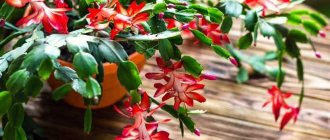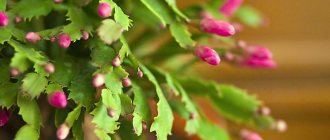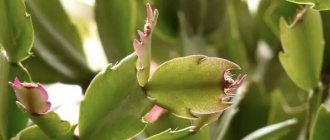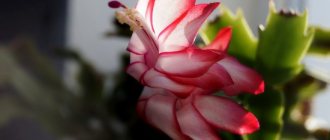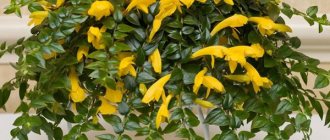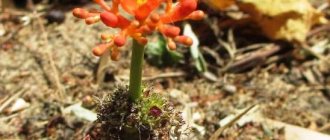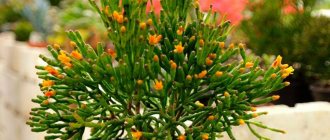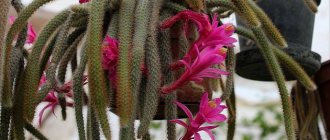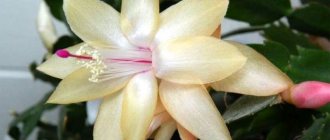This plant will be a great decoration for any interior. Christmas cactus, zygocactus, Rozhdestvennik, Decembrist, Schlumbergera - all these are names of the same flower. In the photo, the Decembrist flowers can be seen in detail.
The birthplace of this miracle is the humid tropics of the southeastern region of Brazil. Decembrist is an epiphytic plant, i.e. growing on other trees or plants. It has branched, flat-shaped stems, which consist of many segments with denticles along the edges.
Pink or red inflorescences ripen and open at the edges of these segments. Flowering time is December or January. When the buds appear and until flowering, you should not disturb or move the plant so that the buds do not fall off.
At the same time, sufficient watering, spraying and nutrition are necessary. At the end of the flowering period, the dosage of watering is reduced and the flower is allowed to rest.
Description of cacti of the genus Schlumberger
Epiphytic cacti of this genus are native to South America. The habitat is located in the coastal mountains of southeastern Brazil. These plants grow on trees or rocks in tropical forests.
Why does this cactus have so many names? Let's figure it out. Folk names for these cacti were given depending on the season of their flowering. In the Northern Hemisphere they are called Schlumbergera, Zygocactus, Christmas cactus, Rozhdestvennik, crab cactus, Decembrist, Varvarin color (or Varvarin braid). In Brazil, this genus is called Flor de Maio (May flower) due to the fact that the flowering period in the Southern Hemisphere falls during the spring season.
Features of cactus taxonomy
The genus Schlumbergera as we know it today contains six to nine species. Charles Lemaire proposed the creation of this genus in 1858 for a plant first described as Epiphyllum russellinum. The genus name is given in honor of the French cactus collector Frederic Schlumberger, who at that time was famous for his collection of cacti. The flower Schlumbergera russelliana has become the type species of the genus. In subsequent years, a number of new species were discovered and described. The problem of merging (“unification”) and division of genera arises constantly, and Schlumberger is an example of this. For many years there has been confusion as to how the various species of many epiphytic cacti should be divided into genera. This problem also affected Schlumbergera. In 1819, Haworth discovered and described another species of cactus - Epiphyllum truncatum. In 1890, Karl Moritz Schumann created a new genus, Zygocactus, and transferred Epiphyllum truncatum to Zygocactus truncatus. Although he later placed it back into Epiphyllum, abandoning Zygocactus. Despite this, the name Zygocactus continues to be widely used in various sources and online stores. In 1953, Reid Moran placed Schlumbergera russelliana and Zygocactus truncatus in the genus Schlumbergera. Other species were added later, including those formerly classified as Epiphyllanthus, thereby forming the genus Schlumberger of six species and a number of hybrids.
Biological description of the Decembrist
In their natural habitat, Schlumbergers grow on the branches of other plants (epiphytes) and in shady areas of cliffs and rock crevices. Cacti do not have true leaves, although their round and flat stems are often considered leaves. Young plants are erect, but as they mature the stems begin to bend and become drooping.
For the most part, Zygocactus or Christmas tree is a small bush growing up to 30 cm in height and 60 cm in diameter. The hanging branches of Schlumbergera are mostly flat and green in color and can reach a length of up to 1 meter. Decembrist stems do not have needles. Branch segments of various species have more or less distinct serrations along the edges. Flowers bloom at the tips of the branches.
Photo of Decembrist or Schluberger fruits
The flowers are two-tiered, tubular up to 8 cm long, visually look like a flower within a flower. Depending on the variety, they can be peach, red, pink, purple, orange or white. This variety of colors has been achieved thanks to the development of many cultivars and hybrid varieties of Zygocactus.
These flowering cacti can live 20 to 30 years if cared for properly.
A few words about the flowering season of Schluberger or Decembrist
Different species of Zygocactus have different flowering periods: from the end of November to the end of winter, the widespread hybrid species Schlumbergera Buckley blooms, and the truncated Schlumbergera (S. truncatus) blooms from the end of December to February.
Many people do not know, but because of this difference in flowering time, these varieties are called differently: the first species is called Decembrist and the other, better known as Zygocactus truncated, is commonly called the Christmas cactus or Varvarin flower (it begins to bloom in December, closer to Varvarin day).
What is the difference between Schlumbergera and Ripsalidopsis?
Often inexperienced flower growers classify the so-called “Easter cactus” or Ripsalidopsis among the Decembrists, since they are very similar in appearance. But there are still differences between them. We described in detail the distinctive features of the Christmas cactus and the Easter cactus in our article.
There are more than 200 artificially bred varieties of Schlumbergera, which in turn once again emphasizes the great popularity of this cactus among gardeners.
Varieties of Decembrist
There are not only the familiar varieties of Decembrist, but also hybrid forms. Breeders did not stand aside and carried out painstaking work to develop interesting varieties that amaze with a riot of colors and a variety of shades.
Decembrist white
White inflorescences against the background of dark green foliage look simply delightful. This flower will decorate any room. There are several varieties of Decembrist that have white flowers. These include:
- White Christmas;
- Bridgeport;
- Angel Dance;
- White Bell;
- Aspen.
White Decembrist looks very elegant, thanks to the contrast of dark green leaves and snow-white inflorescences
The white-flowered hybrid Malissa deserves special attention. It has rather short stems, but very large flowers. The flowering period lasts up to 3-4 months. The center is painted lavender. The inflorescence is capable of changing its color depending on the temperature in which it is kept. In cool conditions a slight pink tint appears.
Decembrist pink
Decembrist with pink flowers is the most common type. This plant is most often found on the windowsills of amateur gardeners. Popular varieties with pink flowers are:
- Gertner;
- Russelliana;
- Buckley;
- Truncata;
- Mix;
- Orsichiana;
- Opuntioides;
- Lavender Doll;
- Lavender Fantasy;
- Christmas Flame;
- Cambridge;
- Dark Eve or dark;
- Madame Butterfly and others
Pink Decembrist varieties are the most common
Every year new hybrids appear on the market that can delight even those who are skeptical about this plant.
Yellow Decembrist
The yellow color of Decembrist flowers is uncharacteristic for this plant in natural conditions. Breeders worked on its creation for a very long time and painstakingly. Only after 15 years of work they managed to get a Christmas tree with yellow flowers. They are characterized by wide and long stem segments of a dark green color, from which shoots with a vertical growth pattern are formed. The most popular varieties include:
- Golden Cream;
- Gold Charm;
- Christmas Flame or Gold Fantasy;
- Cambridge;
- Golden Orpheus.
Yellow Decembrist was obtained artificially, thanks to many years of work by breeders
Decembrist red
The red color of flowers is quite common among the Decembrist, although flower growers prefer pink shades. Connoisseurs of rich and bright colors have fallen in love with the following varieties:
- Gertner;
- Kautsky;
- Christmas Fantasy;
- Pasadena;
- Kris Kringle.
Red Decembrist looks very beautiful, although it is inferior in popularity to pink varieties
And others
In addition to the listed varieties of Decembrist, plants with purple or orange colored flowers are actively grown on the window sills of flower growers. Sometimes they can be combined with white in various combinations. During the flowering period, this Decabrinka takes on an elegant, unusual appearance. Not everyone even immediately recognizes it in such an unusual form. The most popular varieties include :
- Peach Parfait;
- Bridgeport;
- Twilight Tangerine;
- Christmas Cheer;
- Santa Cruz;
- Microsphaerica;
- Truncata.
Orange Decembrist is not so often seen on the window sills of gardeners
Rare varieties and hybrids are found mainly in the collections of true Decembrist connoisseurs. They are constantly hunting for interesting new products that breeders bring to their attention. Each variety is of great value, both for amateurs and professional florists.
Decembrist with purple flowers is a real exclusive
What you need to know about caring for Schlumberger cactus at home
To begin with, we want to make one remark - do not treat the Decembrist as an ordinary cactus. They do not tolerate the same climate conditions as other succulent crops and often do not bloom. We will try to provide detailed information and describe all the intricacies of growing homemade Zygocactus.
The soil
The choice of soil mixture composition is not a significant factor for Schlumbergera. The cactus can adapt to most types of houseplant soil and can thrive in loam, sand, perlite, succulent mix, and even regular potting soil. But to achieve optimal conditions for development, Decembrist needs soil with a pH of 5.5 to 6.2. You can prepare the soil for Zygocactus yourself by mixing one part sand and two parts regular fertile soil. To increase acidity, it is advisable to add a little peat.
Where is the best place to place a pot with Decembrist?
To determine the location of the flower, you need to remember that Schlumbergera grows in tropical climates, but grows away from direct sunlight. Especially during a hot lunch hour, the plant can be seriously damaged by the sun. The cactus needs a well-lit but slightly shaded place.
The flower will tolerate a few hours of direct sunlight in the morning or evening. On the other hand, in too dark locations the cactus will etiolate due to lack of light. The consequence will be the rapid growth of Schlumberger and the weakening (yellowing) of its tissues. A window sill on the east or west side will be the optimal place for Zygocactus. Closer to noon, try to keep the flower under diffused lighting.
If you want to take the Decembrist pot outdoors, make sure it is in partial shade.
Temperature and humidity
There are also important factors that will influence the condition of your cactus. Rozhdestvennik is a little picky when it comes to temperature.
- During periods of vegetative growth (from April to September) it prefers mild temperatures of 17-26 °C.
- When flower buds begin to form, Zygocactus should be provided with a lower temperature range at night (12 to 18 °C).
- After the buds open, the temperature should be 21-24 °C during the day and 16-21 °C at night.
- At the end of the flowering season, Schlumbergera should rest. During this period, the plant requires less humidity, a cooler environment (10-12 °C) and less light (12-14 hours of darkness).
Keep it away from frequently opened doors and drafts; this plant does not like sudden drafts and will drop its buds.
Decembrist prefers medium humidity levels. So, if you are keeping the plant in a dry place, you can place a container filled with water near the pot to increase the humidity level. But in winter, the air in the room should be quite dry. Keep tropical cactus away from heat sources (radiators and fireplaces).
Cactus care information
What soil is needed to grow cacti?
How to water cacti correctly to avoid mistakes in care
How to properly use fertilizer for cacti at home
Watering
Schlumbergera craves more moisture than other cacti because they are endemic to tropical and subtropical forests. Water thoroughly, then empty the drainage tray. Allow the surface of the soil to dry out before watering again. When watering Decembrist, consider the time of year and the environment. If you keep the plant outdoors in the summer in a hot, dry climate, water it every two to three days and place it in a shaded area.
In a cool, humid environment, especially if it is indoors, Schlumberger should be provided with a once-a-week watering schedule. To encourage flowering, reduce watering in the fall and early winter.
This cactus will also not tolerate constantly soggy soil, which can lead to root rot and stem rot. Stems that are too soft or yellowed are the first symptoms of overwatering. Also, do not allow the soil mixture to dry out completely - the stems will begin to wrinkle and wither, and the flowers will begin to fall off prematurely. After the flowering season has ended, water less frequently until the new growing season begins in the spring.
How to apply fertilizers correctly
Feed Zygocactus every 2 weeks from spring to autumn with a water-soluble cactus fertilizer containing beneficial microelements. Regular feeding will give your plant more energy to form flowers. In the fall, fertilize the cactus once a month until the buds begin to form. As soon as you notice the formation of flower buds, stop feeding. After the Decembrist has faded, you can resume monthly feeding.
Schlumberger Trimming
There are several types of Decembrist pruning seasons.
- Plants can be pruned in late spring to encourage branching and more future flowers. Simply cut off a few segments of each stem and the Zygocactus will begin to branch from where you cut it.
- Decembrist is also pruned immediately after it blooms. This will also cause the plant to branch.
- Sanitary pruning can be carried out throughout the season, removing dead or damaged shoots.
To prune Schlumbergera, simply twist the stem between one of the segments. You can also use a sharp knife or scissors to remove excess segments. The best option would be to remove up to one third of the plant per year. Drastic pruning is also possible, shortening the shoot to one or two segments. If you wish, plant the cut segments in a container with slightly moist, fertile soil - they will take root easily in a few weeks. We will talk about this below.
You can learn more about pruning Zygocactus from this video.
Decembrist transplant
This flower loves to be in a pot, try not to disturb it - no more than once every three to four years. Frequent replanting can harm the health of the plant and cause it to stop blooming for a while. If you notice a lot of roots growing out of the drainage holes, it's time to find a new container.
Unlike other indoor flowers, which are best replanted in the spring, to replant Zygocactus you need to wait until the flowers finish blooming and wilt in late winter or early spring. Never repot a plant while it is actively blooming.
The best pots for Schlumberger are terracotta or clay. These materials are porous and drain water well from the roots of the flower, which may suffer from overwatering. The pot should have enough drainage holes. For transplantation, choose a container two to three centimeters larger in diameter than the current one. A larger pot may hold too much moisture or encourage the spread of insects and plant diseases.
Planting and feeding zygocactus
How to determine that a Decembrist needs a transplant? When the roots begin to crawl out of the drainage hole, this is a sign that it needs to be transplanted into a slightly larger pot. If the flower has not been replanted for a long time, but the roots have not grown enough for replanting, then you can simply renew the top layer of soil.
The best soil composition for Schlumbergera:
- Fine perlite, peat and leaf soil in a ratio of 1:1:3
- Leaf soil, peat and sand in a ratio of 1:1:1.
- Ready soil for cacti.
When planting, add charcoal (birch) to the prepared soil. You can add sphagnum.
When preparing a pot for planting, keep in mind that it should not be spacious. Firstly, so that Schlumbergera can bloom in the same season, and not waste energy on forming a large root system. And secondly, so that the roots in a pot that is too spacious do not rot. It is better to choose a lower and wider slide.
So, we have chosen a suitable pot. Pour one third of drainage into the bottom (expanded clay is best). Let's try on our flower and add the required amount of prepared earth mixed with ash.
Let's put the bush up, cover it with soil up to the growing point and press it down a little. Leave some soil so that during the shrinking process you have something to add to the pot. There is no need to water for the first two or three days! This way the Decembrist will better withstand the stress of the transplant.
On average, you need to feed twice a month. See life cycle table.
You can use complex fertilizers for ornamental flowering plants, fertilizers for cacti and fertilizers for flowering plants during the flowering period. If you are not using the fertilizer for cacti, then reduce the dosage by half.
During the growing season, when the Decembrist grows leaves, you can spray it with nitrogen. To do this, you can use ammonia (ammonia). In this form it is easier for the flower to assimilate. Consumption for watering: 1 teaspoon per liter of water.
Video about growing Decembrist
Video - how to achieve constant flowering of the Christmas tree
How to Make Your Schlumbergera Cactus Bloom
Flowering of Christmas cacti and their hybrid varieties is triggered by cooler temperatures and longer autumn nights. The two main types of Zygocactus tend to bloom around the Christmas period. But often cacti lovers may encounter such a problem when Schlumbergera does not bloom. Let's figure out what the problem is and how to fix it.
- Lighting. If your cactus isn't blooming, it's likely getting too much light or being in a room that's too warm. In order for this tropical plant to please you with its spectacular flowers, you need to provide it with certain conditions that must be strictly adhered to. To cause Decembrist to bloom, in the other half of autumn it is necessary to reduce the period of illumination of the cactus to 8 - 10 hours for at least six weeks. Night mode should last at least 14 hours. If the room where the flower pot is located constantly has artificial lighting turned on during the dark period of the day, it is worth covering the cactus or moving it to a place exposed to the natural light cycle.
- Temperature conditions. Flower buds form best when the plant is exposed to temperatures between 10 and 15°C during the day. To start the budding process, provide the Decembrist with a room with a night temperature of about 7 °C for one week.
- Correct hydration regime. To encourage flowering, reduce watering in the fall and early winter. If the plant is dried out too much, it may drop its flowers.
When the flowers open, the frequency of moistening should be increased slightly and the plant should be moved to a more illuminated window. Make sure the room where the Zygocactus will be located is warm enough, otherwise the cold may cause the buds to drop.
In this video you can learn about caring for Zygocactus at home.
Possible problems during cultivation
When cared for in accordance with all the rules, zygocactus grows well and blooms profusely. However, problems may arise during cultivation, so it is recommended to study the main ones.
Diseases and pests of the Decembrist
The plant can be attacked by some insects and fungal diseases. Therefore, the leaves of the plant need to be inspected periodically.
- If whitish lumps like cotton wool appear between the shoots, it means that the Decembrist is infected with a mealybug. Getting rid of the pest is quite difficult. The plant needs urgent treatment with special preparations that are sold in flower shops.
- Leaves covered with a rusty coating and almost invisible cobwebs indicate that the zygocactus is infected with spider mites. These are very small and almost invisible insects of a reddish, yellow or brown color. They appear when there is insufficient air humidity. You can get rid of them with the help of the drug “Neoron”, “Fitoverm”, “Actellik”.
- Of the fungal diseases, Decembrist is most often affected by late blight, phytum, and fusirium. First of all, the root neck of the flower suffers, as a result of which it begins to wither in moist soil, becomes gray and pale, and loses its segments. In this case, the plant must be treated with Vitaros, Topaz and Maxim fungicides. In addition, you need to ensure that the soil does not become waterlogged. It should dry out well between waterings.
Why doesn't the Decembrist bloom?
Most often, the reason lies in non-compliance with growing conditions:
- Insufficient watering.
- Insufficient lighting.
- The pot is too small for the plant and requires replanting.
- Insufficiently nutritious soil.
In order for a plant to bloom, it must be properly prepared for flowering. To do this, in the fall they provide him with a period of rest by removing the zygocactus into a cool room. At this time, it practically does not need to be watered and does not need to be fed at all. To make the zygocactus bloom, at the end of November it is moved to a well-lit place and watered. The plant will “wake up” and begin to produce buds.
To achieve abundant flowering of the Decembrist, you need to properly care for it:
In winter, it is recommended to illuminate the plant with an additional lighting source. During the flowering period, you should not move or rotate the pot, or prepare cuttings for propagation. It is strictly forbidden to expose the plant to temperature changes during flowering. If there is cool air in the room, flowering will last longer. The bush will bloom profusely in a narrow pot. Temperature conditions no higher than +16C promote more active flowering. After a period of rest, watering and fertilizing are resumed very carefully. Otherwise, the plant may get very stressed and drop its buds.. If you brought a blooming Decembrist home, and its flowers began to fall off, there is no need to panic
The plant simply adapts to new growing conditions
If you brought a blooming Decembrist home, and its flowers began to fall off, there is no need to panic. The plant simply adapts to new growing conditions.
Why does the zygocactus wither?
As already written above, the plant withers if it suffers from fungal diseases. But there may be another reason - rotting roots.
If the trunk of the Decembrist began to sway, and the flower itself lost stability, then it is possible that its roots died. This can happen as a result of watering with cold water, hypothermia of the plant, or, conversely, from overheating of the flowerpot in the sun. Too much fertilizer can burn the roots.
If such a problem is detected, the flower must be urgently transplanted into another soil. The roots are inspected during transplantation, and the affected ones are removed. Then the root system of the plant is sprinkled with a little crushed coal and dried. After this, the zygocactus is planted in a fresh earthen mixture and watered only as needed.
Why do the leaves fall?
Decembrist leaves can fall, seemingly for no reason. However, nothing happens that simply, so you should find out the reason:
- If a plant is infected with pests, it is treated with special preparations.
- If the leaves of the plant are clean and there are no insects on them, then perhaps the reason is a lack of nutrients. In this case, the Decembrist is watered or sprayed with fertilizers for epiphytic cacti.
- The reasons for the fall of the final segments can be: draft, sudden temperature changes, too dry air or a transplant done at the wrong time.
How to propagate the Decembrist cactus
Schlumberger is propagated by two methods - cuttings and seeds. The best time to propagate Zygocactus is one to two months after the end of flowering. You should not propagate it in autumn and winter, when it sets buds and actively blooms. The easiest way to propagate Christmas trees is from stem cuttings.
Cuttings
- First of all, prepare the container and fill it with substrate for cacti, universal soil mixture for flowering crops or sand-peat soil.
- Using a sterile knife or scissors, cut off a section of the stems with three to five segments on each.
- Place the cuttings in a cool, dry place for a couple of days until the cutting area is dry.
- Then lightly press the cuttings about 3 cm deep into the slightly moistened soil. Water the soil well. To create a moist environment and encourage rooting, cover the container with a clear plastic bag.
- Water the soil regularly and allow the soil to dry out between waterings. It takes two to three weeks for roots to form. Remove the film when the cuttings take root.
If desired, you can root the stems in water before planting them in soil. Place the cut end into 3-5 cm of filtered water and place the jar in a window with indirect light.
After a few weeks, the cuttings should produce roots at least 4 cm long and then they are transplanted into a pot.
How to grow Schlumberger from seeds
You can collect cactus seeds from the fruits of the plant. Wait until they turn pink. Fruit formation usually occurs in the fall.
Remove the dark brown seeds and wash off the pulp.
- Plant the seeds in moist soil with perlite or cactus soil mixture. Press the seed lightly into the soil without covering it, or sprinkle a thin layer of sand on top.
- Cover the pot with clear film or glass to increase the humidity in the container.
- Place the container on a lighted windowsill, but out of direct sunlight.
- Regularly spray the soil surface with water every day.
- In two to three weeks, shoots should appear. Remove the film or glass as soon as you notice the seedlings growing.
- Transplant the seedlings into individual pots when they are large enough.
Reproduction
Cuttings
The easiest way to propagate Schlumberger vegetatively is by using stem cuttings consisting of a couple of segments.
They do this after the crown has formed, when there is a lot of cuttings of shoots left, or from April to May during the active growing season of plants. The cuttings are separated from the mother flower, dried for 2 days and rooted in water or in moist soil under a greenhouse.
Seeds
New hybrid Schlumberger varieties are grown from seed material. Getting your own seeds is a troublesome task, since the plants need pollination, so store-bought seeds are usually used. The optimal time for sowing is from May to June. Pre-sowing treatment of seed material involves heating it at 50-60°C and soaking it in a biostimulant solution. Next, the seeds are placed in a container with wet sand or a soil mixture of sand and earth, without deep planting, under a greenhouse. The temperature inside is maintained at 23-25°C, the seedlings are watered and they are provided with regular ventilation. You have to wait from 3 weeks to a month for the first shoots to appear. After 1.5-2 months from the moment the shoots appeared, the plants dive. You can expect flowering only 2-3 years after sowing.
Vaccination
To obtain the standard form of Decembrist, it is grafted onto other cacti such as prickly pear, cereus, and pereskia. To do this, cut off the upper part of the cactus rootstock, place the Decembrist rootstock in the cleft in the form of a cutting of three fragments and fix it with a toothpick or cactus spine, and then wrap it with cloth or thread. The fusion of the scion with the rootstock takes from half a month to 3 weeks. After this, the bandage is removed and the standard zygocactus is tied to one or two supports by the trunk and crown so that it does not break at the grafting site due to its weight. Compared to ordinary Decembrists, plants on the trunk have much more luxuriant flowering.
What problems may arise in caring for Schlumberger's?
Zygocactus is a heat-loving plant, quite sensitive to temperature and humidity. Often a neglected flower may lose its luxurious appearance and not bloom. What reasons could lead to the deplorable state of the Decembrist?
- Stunted growth. If your cactus becomes stunted or twisted, carefully inspect it for mealybug infestation. These pests look like tiny white cottony specks. They move slowly and often appear first on the lower surface of a segment or in darker, moist areas near the base of the stem. Beetles feed on plant sap and leave behind sticky honeydew, which causes mold to form on the plant.
- Yellowing, spotted or wilting leaves or stems . If you notice yellowing of stem segments, their spotting or wilting, carefully inspect the flower for the presence of thrips. These pests appear as thin black stripes or tiny insects. Damage to stems is not caused by thrips, but by a virus that they usually carry. Treat your plant immediately with insecticidal soap or another product. It may be necessary to transfer the Decembrist to a new sterile pot with fresh soil mixture. Wilting can also be caused by insufficient light, insufficient water, or a pot that is too cramped. Correct these problems and watch closely for improvements in growth.
- The stems turn red or pink. When Decembrist receives too much sun or too little water, a change in the color of the branches occurs. In this case, it is worth moving the flower pot to a more shady place with partial lighting. Also try to control the frequency of moisturizing.
But these are not all the problems that Zygocactus may encounter.
Does a similar shade exist in nature?
In the wild, the plant lives in the tropics of Southern Brazil and Paraguay. It grows on fallen trees, roots and hollows protruding from the ground, as well as on low-lying branches. In nature, Schlumbergera, as noted above, does not bloom with yellow flowers. Only long-billed hummingbirds can pollinate it. They are able to distinguish all colors, but still prefer different shades of red.
In general, the yellow color is characteristic of the cactus family, so the Decembrist initially had such a pigment. Otherwise, it would be impossible to breed Decembrist with yellow flowers.
Common pests and diseases of the Decembrist
In addition to the parasitic insects described above that affect Christmas trees, you can also find aphids and spider mites on cacti. It is worth remembering that overwatering the plant and damp soil most often leads to the appearance of these pests. Insecticidal preparations are effective in controlling these small pests. They can also be removed by blotting with a cotton swab soaked in alcohol.
Also, with excessive watering, Schlumberger's fungal diseases often occur. Fusarium and late blight are two common fungi that can cause stem rot. Fusarium stem rot causes the formation of brown spots on the stem near the soil surface. Late blight stem rot causes the shoot to appear too soft and wet at soil level. Late blight is deadly. Your cactus can be saved if the disease is detected early enough. If the potting soil is too wet, allow it to dry out and then apply a fungicide according to package directions. Avoid overwatering.
Watering and humidity
The beautiful photo of Decembrist flowers is simply stunning. But how to achieve such harmony in your own home? Here it is worth adhering to proper watering and moisture. This plant requires abundant and, most importantly, regular watering.
But there should not be stagnation of water here. There must be a slight middle ground.
But this species is picky about the water itself. It does not appreciate the limestones that may be present there and therefore it is important to water with pre-prepared water. This is boiled and room temperature water.
We recommend reading:
- Flowers in August: photos and description
- Garden flowers that bloom in July: photos and names
Lilac - varieties, types, selection rules, planting nuances, cultivation secrets and care (105 photos and videos)
The humidity of the room should also be average; high humidity will be too destructive for such a homemade variety. The plant will also require spraying.
Main types of Schlumberger cactus
Although science knows about six varieties of this succulent plant, only three species have gained popularity among gardeners.
Schlumbergera truncata or Zygocactus truncata (Schlumbergera truncata)
This is a cactus with stems consisting of flat segments with 2-3 teeth of various shapes along the edges. Individual segments are up to 6 cm long and up to 4 cm wide.
Flowers are up to 4 cm long, usually reddish in color. Flowering time is from late November or early December to February.
Schlumbergera russelliana
This view visually resembles the previous one with some differences. The stems of the flower are the same shape, but the segments are slightly smaller, up to 4 cm in length, and the edges do not have such clear teeth but several smooth notches.
The buds are formed in two rows (“flower within a flower”), with the top row being the perianths. It is also worth noting that the flowering season for this species in the Northern Hemisphere is spring (February to April).
Schlumbergera x buckleyi
This cactus is a hybrid of two previous Zygocactus species: Schlumbergera truncata × Schlumbergera russelliana. In the 1840s, William Buckley developed this variety of Schlumberger. It is he who is rightly called the Decembrist or Rozhdestvennik.
This hybrid flower received its appearance and size from its parents. As a result of further hybridization and selection, more than 200 different varieties of this hybrid plant were obtained, differing mainly in flower colors: from pure white to pink, red, orange, yellow and others.
Photos of flowers of hybrid varieties of Zygocactus or Decembrist
As its name already suggests, the flowering season begins in December and lasts until spring.
We hope that in this article we have answered all the important questions regarding the growing and flowering conditions of Schlumberger or Decembrist. If you have any comments or questions, write to us and we will be happy to answer.
The article uses materials from the sites: plantopedia.com, gardenbeast.com, wikipedia.org.
Where did you come from, handsome?
On my grandmother’s window there grew a nondescript bush with hanging leaves. But once a year he was transformed. Before the winter holidays, he dressed in delicate oblong buds.
And on New Year's Eve we didn't recognize him. A handsome man appeared at the window, shrouded in a pink-green cloud. Each branch was decorated with a bright terry butterfly with thin stamens.
Granny called her pet differently, but I remember the fairytale name “Varvarina braid.” He gave joy and New Year's mood.
This epiphyte did not always live in a temperate climate.
The homeland of Schlumbergera (one of its several names) is tropical Brazil. Belongs to the class of epiphytic, that is, hanging, cacti.
It grows on trees, clings to the bark and collects moisture in the leaves. It differs from its prickly relatives in its love for a humid environment. The natural environment for zygocactus is high humidity, temperatures above 20 degrees, crowded conditions and shade.
In indoor living, the same factors are important for him.

